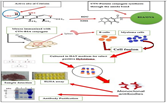
Shimuye Kalayu Yirga
Woldia University, Ethiopia
Title: Preparation and characterization of monoclonal antibodies against citrinin (CTN) for immunoassay VP
Biography
Biography: Shimuye Kalayu Yirga
Abstract
Citrinin (CTN) is a hepato-nephrotoxic mycotoxin produced by fungi genera of Aspergillus, Monauscus and Penicillium. CTN contaminates grains, fruits, juices and vegetables cause various toxic effects to humans and animals. The commonly used analytical methods for CTN detection were TLC), HPLC, LC-MS/MS, (GC-MS). However, these methods have lack of potential for automation, low sensitivity, low specificity, complex equipment’s, incompatible with the real sample, energy and time consuming. Citrinin is a small non-immunogenic toxin with a molecular weight of 250.25 g/mol. Thus, it is necessary to conjugate it with carrier proteins for an immuno-response to generate antibodies. Different methods were applied to conjugate CTN with carrier proteins. Bio coupling method was not satisfactory due to difficulties in removing unconjugated materials through dialysis furthermore; in our study the formaldehyde condensation method was also not effective with the conjugation of CTN-OVA because the result of conjugation was not stable. Finally , in this study CTN was conjugated to bovine serum albumin (BSA) and ovalbumin (OVA), respectively, by amide bonds through active ester method using 1-ethyl-3-(3-dimethylaminopropyl) carbodiimide hydrochloride (EDC) and N-hydroxysuccinimide (NHS). In this study, Female Balb C mice were immunized with CTN-BSA conjugate and Obtained a high anti-serum titer (1:32,000 v:v) when compared to the non-immunized control mouse. Spleen cells of the immunized mice were fused with Sp2/0 myeloma cells to obtain 21H27 hybridoma cell. Ascitic fluid of hybridoma cell was produced in mice abdomen, and purified using caprylic/ammonium sulfate precipitation method. The 21H27 anti-CTN mcAb was the IgG2a antibody subclass, and cross-reactivity results indicated that anti-CTN mcAb is specific to CTN with high affinity (2.0-108 L/mol). Indirect competitive ELISA (IC-ELISA) results showed that the linear range of detection was 0.01–5.96 ng/mL and the IC50 was 0.28 ng/mL with a lower detection limit (LOD) of 0.01 ng/mL. The average recovery was 93.8%-1.6% with a coefficient variation of 1.0%-4.3%. Hence, anti-CTN mcAb secreted by 21H27 hybridoma cell was successfully produced and can be used to detect CTN contaminated feed and foodstuffs.
In this study, 2 mL of sodium citrate and 8.2 pH adjusted with potassium chromate was applied for preparation of good color gold solution. In addition to this, freshly prepared (within one week shelf life) anti-CTN mcAb gold conjugated and optimum concentration of coating antigen were the appropriate parameters for the best achievement of anti-CTN mcAb immuno-chromatographic test strip assay.

Figure 1 Graphic summary of monoclonal antibody production against Citrinin for immunoassay.

